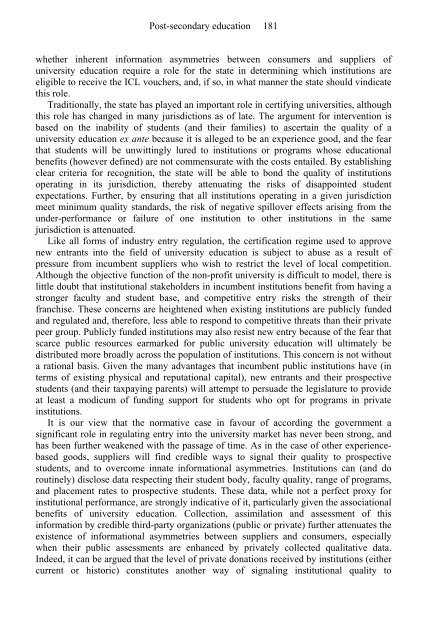Rethinking the Welfare State: The prospects for ... - e-Library
Rethinking the Welfare State: The prospects for ... - e-Library
Rethinking the Welfare State: The prospects for ... - e-Library
Create successful ePaper yourself
Turn your PDF publications into a flip-book with our unique Google optimized e-Paper software.
Post-secondary education 181<br />
whe<strong>the</strong>r inherent in<strong>for</strong>mation asymmetries between consumers and suppliers of<br />
university education require a role <strong>for</strong> <strong>the</strong> state in determining which institutions are<br />
eligible to receive <strong>the</strong> ICL vouchers, and, if so, in what manner <strong>the</strong> state should vindicate<br />
this role.<br />
Traditionally, <strong>the</strong> state has played an important role in certifying universities, although<br />
this role has changed in many jurisdictions as of late. <strong>The</strong> argument <strong>for</strong> intervention is<br />
based on <strong>the</strong> inability of students (and <strong>the</strong>ir families) to ascertain <strong>the</strong> quality of a<br />
university education ex ante because it is alleged to be an experience good, and <strong>the</strong> fear<br />
that students will be unwittingly lured to institutions or programs whose educational<br />
benefits (however defined) are not commensurate with <strong>the</strong> costs entailed. By establishing<br />
clear criteria <strong>for</strong> recognition, <strong>the</strong> state will be able to bond <strong>the</strong> quality of institutions<br />
operating in its jurisdiction, <strong>the</strong>reby attenuating <strong>the</strong> risks of disappointed student<br />
expectations. Fur<strong>the</strong>r, by ensuring that all institutions operating in a given jurisdiction<br />
meet minimum quality standards, <strong>the</strong> risk of negative spillover effects arising from <strong>the</strong><br />
under-per<strong>for</strong>mance or failure of one institution to o<strong>the</strong>r institutions in <strong>the</strong> same<br />
jurisdiction is attenuated.<br />
Like all <strong>for</strong>ms of industry entry regulation, <strong>the</strong> certification regime used to approve<br />
new entrants into <strong>the</strong> field of university education is subject to abuse as a result of<br />
pressure from incumbent suppliers who wish to restrict <strong>the</strong> level of local competition.<br />
Although <strong>the</strong> objective function of <strong>the</strong> non-profit university is difficult to model, <strong>the</strong>re is<br />
little doubt that institutional stakeholders in incumbent institutions benefit from having a<br />
stronger faculty and student base, and competitive entry risks <strong>the</strong> strength of <strong>the</strong>ir<br />
franchise. <strong>The</strong>se concerns are heightened when existing institutions are publicly funded<br />
and regulated and, <strong>the</strong>re<strong>for</strong>e, less able to respond to competitive threats than <strong>the</strong>ir private<br />
peer group. Publicly funded institutions may also resist new entry because of <strong>the</strong> fear that<br />
scarce public resources earmarked <strong>for</strong> public university education will ultimately be<br />
distributed more broadly across <strong>the</strong> population of institutions. This concern is not without<br />
a rational basis. Given <strong>the</strong> many advantages that incumbent public institutions have (in<br />
terms of existing physical and reputational capital), new entrants and <strong>the</strong>ir prospective<br />
students (and <strong>the</strong>ir taxpaying parents) will attempt to persuade <strong>the</strong> legislature to provide<br />
at least a modicum of funding support <strong>for</strong> students who opt <strong>for</strong> programs in private<br />
institutions.<br />
It is our view that <strong>the</strong> normative case in favour of according <strong>the</strong> government a<br />
significant role in regulating entry into <strong>the</strong> university market has never been strong, and<br />
has been fur<strong>the</strong>r weakened with <strong>the</strong> passage of time. As in <strong>the</strong> case of o<strong>the</strong>r experiencebased<br />
goods, suppliers will find credible ways to signal <strong>the</strong>ir quality to prospective<br />
students, and to overcome innate in<strong>for</strong>mational asymmetries. Institutions can (and do<br />
routinely) disclose data respecting <strong>the</strong>ir student body, faculty quality, range of programs,<br />
and placement rates to prospective students. <strong>The</strong>se data, while not a perfect proxy <strong>for</strong><br />
institutional per<strong>for</strong>mance, are strongly indicative of it, particularly given <strong>the</strong> associational<br />
benefits of university education. Collection, assimilation and assessment of this<br />
in<strong>for</strong>mation by credible third-party organizations (public or private) fur<strong>the</strong>r attenuates <strong>the</strong><br />
existence of in<strong>for</strong>mational asymmetries between suppliers and consumers, especially<br />
when <strong>the</strong>ir public assessments are enhanced by privately collected qualitative data.<br />
Indeed, it can be argued that <strong>the</strong> level of private donations received by institutions (ei<strong>the</strong>r<br />
current or historic) constitutes ano<strong>the</strong>r way of signaling institutional quality to


